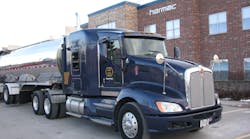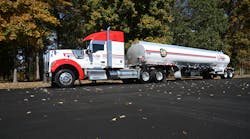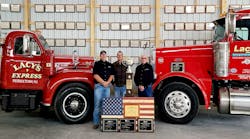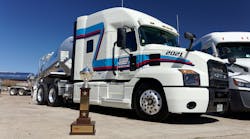TANK TRUCK carriers continue to lead much of the rest of trucking on the economic front. Key drivers include the busy energy sector, a resurgent housing market, and some of the highest factory output in decades.
For hire tank truck loads are projected to increase by around 4.5% in 2013, which is down somewhat from 6.1% growth in 2012, according to Bob Costello, chief economist and vice-president of the American Trucking Associations. He spoke during the 65th National Tank Truck Carriers Annual Conference held April 28-30 in Austin, Texas.
During the first quarter of 2013, tank truck loads grew 6.8% over the previous year. Only truckload intermodal did better at 7.5% during the same period. Dry van loads actually dropped 3.5%.
“Liquid and dry bulk cargo is being generated by a variety of sources,” Costello said. “The housing recovery is real; factory output is climbing; and the energy production boom is here to stay. Washington DC is the biggest drag on US economic growth right now due to tax increases, sequestration, and the ongoing budget debate.”
Housing starts should be in the 970,000-unit range this year, up from 782,000 in 2012. Costello said he expects the economy to improve further in 2014, with housing starts climbing to the 1.2 million level. Home prices are increasing at the fastest clip since 2006.
Factory output is now at the highest level since 2011, and the Chinese are seeing the impact of increased competition from the United States, according to Costello. Factory output surged 4.2% in 2012 and is expected grow another 3.4% in 2013 and 3.7% in 2014.
On the energy front, natural gas production surged over the past nine years and is still at very high levels even though prices fell significantly. Crude oil production also surged, and the United States now exports refined fuels. “The United States now has the very real opportunity to achieve energy independence,” Costello says.
Manufacturing and energy sector activity is generating more tank truck cargoes. Plastics production is expected to grow by about 4.5% per year over the next three years, including a 5.8% gain this year. After two years of flat output, US chemical production is expected to increase 2.3% this year and average 3.1% per year over the next three years.
Reflecting the growth in homebuilding, paint production is projected to rise an average of 5.7% annually over the next three years. Cement production should grow 7.2% per year on average over the next three years, including a 4.2% gain this year. Costello noted that cement production is still very depressed.
Shrinking capacity
Even as shipments grow for the tank truck industry, overall trucking industry capacity is shrinking. In fact, large fleet capacity has fallen 5% since February 2012 and small fleet capacity is down 8.9%.
Costello emphasized that fleets are not buying extra tractors and trailers in anticipation of increased freight movements. “Fleets are running slightly more trucks than there is freight right now, but the levels are very close to equilibrium,” he said. “Capacity has fallen to the point that there simply wouldn’t be enough trucks on the road today to handle all of the freight is the economy surprised us on the upside.”
The changes in hours of service that took effect July 1 will constrain capacity even more. “ATA estimates that the hours-of-service changes will reduce productivity in the 1.5% to 4% range, depending on type of truck fleet,” Costello said.
Driver shortage
Drivers are a key contributor to the tightening capacity in the trucking industry. Even before the hours of service changes, fleets were having trouble finding enough qualified truck drivers. The rebound in home construction is one of the factors driving the driver shortage.
Costello pointed out that there are far fewer truck drivers available than data would suggest. Approximately 10 million commercial driver license (CDL) holders are registered in the United States, but most are not current drivers and not all are truck drivers.
In 2010, the Department of Labor said there were just over three million “truck” drivers in the United States, but that number includes non-CDL drivers (delivery trucks) and driver/sales occupations (such as bread delivery). ATA has always said that the DOL number was low.
ATA’s best estimate is that there are roughly 2.5 million to three million trucks on the road today that require the driver to have some sort of CDL. Of those trucks, 1.4 million are tractor-trailer units. No more than 750,000 of the tractor-trailer units are used in over-the-road (non-local) operations.
ATA’s best guess is that the trucking industry is short 40,000 truck drivers this year, but it could get much worse. The driver shortfall could climb as high as 239,000 by 2022. “The driver shortage is here; it’s real; and it’s going to get worse,” Costello said.
He noted that the truck driver turnover rate was nearly 100% in 2012. To hold onto current drivers and attract new people, fleets need to address some of the issues contributing to the problem, specifically pay and time away from home.
While average weekly earnings for truckload drivers have increase 56% since 1990, real average weekly earnings fell 11% when adjusted for inflation across that time. “Rates will have to rise to enable carriers to increase driver pay, and shippers know that,” Costello said.
Tank truck carriers are actually in a little better shape on driver pay, with average annual compensation of $54,500. Only fleet have higher average annual pay at $55,000. Refrigerated fleets have the lowest average annual driver pay at $43,000.
Tank truck fleets also do better overall at getting their drivers home more often. Drivers working for tank truck carriers average 6.4 days away from home at a stretch. Truckload dry van drivers average 11.9 days on the road at a time, and reefer drivers are out an average of 18.1 days per trip.
While the US economy continues to improve slowly, the road ahead will be bumpy. Competition remains tough and profit margins are extremely thin. At the same time, there are opportunities for tank truck carriers to grow and thrive. ♦









![James Shaeffer [right], McKenzie Tank Lines Inc and newly elected NTTC chairman, presents a marble plaque to Hans Schaupp, LCL Bulk Transport Inc, in appreciation of Schaupp’s service as the 2012-2013 NTTC chairman. James Shaeffer [right], McKenzie Tank Lines Inc and newly elected NTTC chairman, presents a marble plaque to Hans Schaupp, LCL Bulk Transport Inc, in appreciation of Schaupp’s service as the 2012-2013 NTTC chairman.](https://img.bulktransporter.com/files/base/ebm/bulktransporter/image/2019/04/bulktransporter_859_nttc_2013_e.png?auto=format,compress&fit=crop&q=45&h=139&height=139&w=250&width=250)
